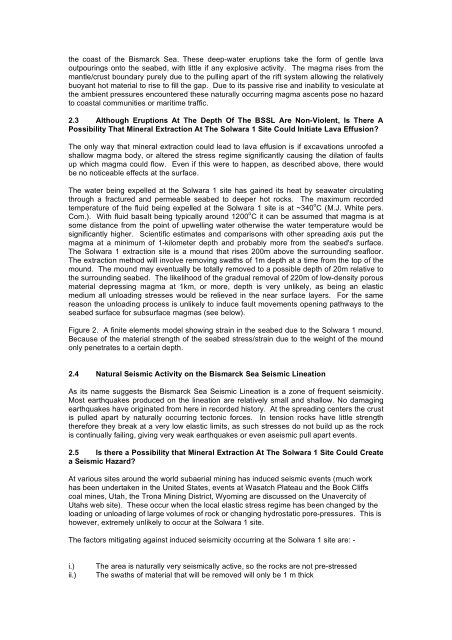Appendices 5-13 - Nautilus Cares - Nautilus Minerals
Appendices 5-13 - Nautilus Cares - Nautilus Minerals
Appendices 5-13 - Nautilus Cares - Nautilus Minerals
You also want an ePaper? Increase the reach of your titles
YUMPU automatically turns print PDFs into web optimized ePapers that Google loves.
the coast of the Bismarck Sea. These deep-water eruptions take the form of gentle lava<br />
outpourings onto the seabed, with little if any explosive activity. The magma rises from the<br />
mantle/crust boundary purely due to the pulling apart of the rift system allowing the relatively<br />
buoyant hot material to rise to fill the gap. Due to its passive rise and inability to vesiculate at<br />
the ambient pressures encountered these naturally occurring magma ascents pose no hazard<br />
to coastal communities or maritime traffic.<br />
2.3 Although Eruptions At The Depth Of The BSSL Are Non-Violent, Is There A<br />
Possibility That Mineral Extraction At The Solwara 1 Site Could Initiate Lava Effusion?<br />
The only way that mineral extraction could lead to lava effusion is if excavations unroofed a<br />
shallow magma body, or altered the stress regime significantly causing the dilation of faults<br />
up which magma could flow. Even if this were to happen, as described above, there would<br />
be no noticeable effects at the surface.<br />
The water being expelled at the Solwara 1 site has gained its heat by seawater circulating<br />
through a fractured and permeable seabed to deeper hot rocks. The maximum recorded<br />
temperature of the fluid being expelled at the Solwara 1 site is at ~340 o C (M.J. White pers.<br />
Com.). With fluid basalt being typically around 1200 o C it can be assumed that magma is at<br />
some distance from the point of upwelling water otherwise the water temperature would be<br />
significantly higher. Scientific estimates and comparisons with other spreading axis put the<br />
magma at a minimum of 1-kilometer depth and probably more from the seabed's surface.<br />
The Solwara 1 extraction site is a mound that rises 200m above the surrounding seafloor.<br />
The extraction method will involve removing swaths of 1m depth at a time from the top of the<br />
mound. The mound may eventually be totally removed to a possible depth of 20m relative to<br />
the surrounding seabed. The likelihood of the gradual removal of 220m of low-density porous<br />
material depressing magma at 1km, or more, depth is very unlikely, as being an elastic<br />
medium all unloading stresses would be relieved in the near surface layers. For the same<br />
reason the unloading process is unlikely to induce fault movements opening pathways to the<br />
seabed surface for subsurface magmas (see below).<br />
Figure 2. A finite elements model showing strain in the seabed due to the Solwara 1 mound.<br />
Because of the material strength of the seabed stress/strain due to the weight of the mound<br />
only penetrates to a certain depth.<br />
2.4 Natural Seismic Activity on the Bismarck Sea Seismic Lineation<br />
As its name suggests the Bismarck Sea Seismic Lineation is a zone of frequent seismicity.<br />
Most earthquakes produced on the lineation are relatively small and shallow. No damaging<br />
earthquakes have originated from here in recorded history. At the spreading centers the crust<br />
is pulled apart by naturally occurring tectonic forces. In tension rocks have little strength<br />
therefore they break at a very low elastic limits, as such stresses do not build up as the rock<br />
is continually failing, giving very weak earthquakes or even aseismic pull apart events.<br />
2.5 Is there a Possibility that Mineral Extraction At The Solwara 1 Site Could Create<br />
a Seismic Hazard?<br />
At various sites around the world subaerial mining has induced seismic events (much work<br />
has been undertaken in the United States, events at Wasatch Plateau and the Book Cliffs<br />
coal mines, Utah, the Trona Mining District, Wyoming are discussed on the Unavercity of<br />
Utahs web site). These occur when the local elastic stress regime has been changed by the<br />
loading or unloading of large volumes of rock or changing hydrostatic pore-pressures. This is<br />
however, extremely unlikely to occur at the Solwara 1 site.<br />
The factors mitigating against induced seismicity occurring at the Solwara 1 site are: -<br />
i.) The area is naturally very seismically active, so the rocks are not pre-stressed<br />
ii.) The swaths of material that will be removed will only be 1 m thick


